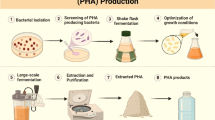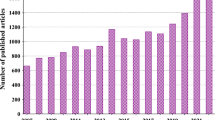Abstract
A process for the conversion of post consumer (agricultural) polyethylene (PE) waste to the biodegradable polymer medium chain length polyhydroxyalkanoate (mcl-PHA) is reported here. The thermal treatment of PE in the absence of air (pyrolysis) generated a complex mixture of low molecular weight paraffins with carbon chain lengths from C8 to C32 (PE pyrolysis wax). Several bacterial strains were able to grow and produce PHA from this PE pyrolysis wax. The addition of biosurfactant (rhamnolipids) allowed for greater bacterial growth and PHA accumulation of the tested strains. Some strains were only capable of growth and PHA accumulation in the presence of the biosurfactant. Pseudomonas aeruginosa PAO-1 accumulated the highest level of PHA with almost 25 % of the cell dry weight as PHA when supplied with the PE pyrolysis wax in the presence of rhamnolipids. The change of nitrogen source from ammonium chloride to ammonium nitrate resulted in faster bacterial growth and the earlier onset of PHA accumulation. To our knowledge, this is the first report where PE is used as a starting material for production of a biodegradable polymer.



Similar content being viewed by others
References
Alexander M (1975) Environmental and microbiological problems arising from recalcitrant molecules. Microb Ecol 2(1):17–27
Al-Salem SM, Lettieri P, Baeyens J (2009) Recycling and recovery routes of plastic solid waste (PSW): a review. Waste Manag 29(10):2625–2643
Arino S, Marchal R, Vandecasteele JP (1998) Involvement of a rhamnolipid-producing strain of Pseudomonas aeruginosa in the degradation of polycyclic aromatic hydrocarbons by a bacterial community. J Appl Microbiol 84(5):769–776
Brandl H, Gross RA, Lenz RW, Fuller RC (1988) Pseudomonas oleovorans as a source of poly(beta-hydroxyalkanoates) for potential applications as biodegradable polyesters. Appl Environ Microbiol 54(8):1977–1982
Butler E, Devlin G, McDonnell K (2011) Waste polyolefins to liquid fuels via pyrolysis: review of commercial state-of-the-art and recent laboratory research. Waste Biomass Valor 2(3):227–255
de Smet MJ, Eggink G, Witholt B, Kingma J, Wynberg H (1983) Characterization of intracellular inclusions formed by Pseudomonas oleovorans during growth on octane. J Bacteriol 154(2):870–878
Doumenq P, Aries E, Asia L, Acquaviva M, Artaud J, Gilewicz M, Mille G, Bertrand JC (2001) Influence of n-alkanes and petroleum on fatty acid composition of a hydrocarbonoclastic bacterium: Marinobacter hydrocarbonoclasticus strain 617. Chemosphere 44(4):519–528
EUPC E, EuPR, PlasticsEurope (2011) Plastics — the facts 2011. An analysis of European plastics production, demand and recovery for 2010. Brussels, pp 1–32
European Commission DG ENV (2011) Plastic waste in the environment. BIO Inteligence Service (ed) Paris, pp 1–171.
Freitas F, Alves VD, Pais J, Carvalheira MN, Costa N, Oliveira R, Reis MAM (2010) Production of a new exopolysaccharide (EPS) by Pseudomonas oleovorans NRRL B-14682 grown on glycerol. Process Biochem 45(3):297–305
Hazenberg W, Witholt B (1997) Effcient production of medium-chain-length poly(3-hydroxyalkanoates) from octane by Pseudomonas oleovorans: economic considerations. Appl Microbiol Biotechnol 48(5):588–596
Hori K, Marsudi S, Unno H (2002) Simultaneous production of polyhydroxyalkanoates and rhamnolipids by Pseudomonas aeruginosa. Biotechnol Bioeng 78(6):699–707
Jung K, Hazenberg W, Prieto M, Witholt B (2001) Two-stage continuous process development for the production of medium-chain-length poly(3-hydroxyalkanoates). Biotechnol Bioeng 72(1):19–24
Juni E, Janik A (1969) Transformation of Acinetobacter calcoaceticus (Bacterium anitratum). J Bacteriol 98(1):281–288
Kellerhals M, Hazenberg W, Witholt B (1999) High cell density fermentations of Pseudomonas oleovorans for the production of mcl-PHAs in two-liquid phase media. Enzyme Microb Technol 24(1–2):111–116
Kenny ST, Runic JN, Kaminsky W, Woods T, Babu RP, Keely CM, Blau W, O'Connor KE (2008) Up-cycling of PET (polyethylene terephthalate) to the biodegradable plastic PHA (polyhydroxyalkanoate). Environ Sci Technol 42(20):7696–7701
Lageveen RG, Huisman GW, Preusting H, Ketelaar P, Eggink G, Witholt B (1988) Formation of polyesters by Pseudomonas oleovorans: effect of substrates on formation and composition of poly-(R)-3-hydroxyalkanoates and poly-(R)-3-hydroxyalkenoates. Appl Environ Microbiol 54(12):2924–2932
Madison L, Huisman G (1999) Metabolic engineering of poly(3-hydroxyalkanoates): from DNA to plastic. Microbiol Mol Biol Rev 63:21–53
Maier RM, Soberon-Chavez G (2000) Pseudomonas aeruginosa rhamnolipids: biosynthesis and potential applications. Appl Microbiol Biotechnol 54(5):625–633
Noordman WH, Janssen DB (2002) Rhamnolipid stimulates uptake of hydrophobic compounds by Pseudomonas aeruginosa. Appl Environ Microbiol 68(9):4502–4508
O'Connor KE, O'Leary NP, Marchesi JR, Dobson AD, Duetz W (2005) Isolation and characterization of a diverse group of phenylacetic acid degrading microorganisms from pristine soil. Chemosphere 61(7):965–973
Preusting H, Nijenhuis A, Witholt B (1990) Physical characteristics of poly(3-hydroxyalkanoates) and poly(3-hydroxyalkenoates) produced by Pseudomonas oleovorans grown on aliphatic hydrocarbons. Macromolecules 23:4220–4224
rx3 (2011) The Irish recycled plastic waste arisings study. Dún Laoghaire, Ireland, pp 1–130
Sabirova JS, Ferrer M, Lünsdorf H, Wray V, Kalscheuer R, Steinbüchel A, Timmis KN, Golyshin PN (2006) Mutation in a “tesB-Like” hydroxyacyl-coenzyme A-specific thioesterase gene causes hyperproduction of extracellular polyhydroxyalkanoates by Alcanivorax borkumensis SK2. J Bacteriol 189(2):289–290
Scheiner D (1976) Determination of ammonia and Kjeldahl nitrogen by indophenol method. Water Res 10(1):31–36
Schlegel HG, Kaltwasser H, Gottschalk G (1961) A submersion method for culture of hydrogen-oxidizing bacteria: growth physiological studies. Arch Microbiol 38(3):209–222
Schneiker S, dos Santos VAPM, Bartels D, Bekel T, Brecht M, Buhrmester J, Chernikova TN, Denaro R, Ferrer M, Gertler C, Goesmann A, Golyshina OV, Kaminski F, Khachane AN, Lang S, Linke B, McHardy AC, Meyer F, Nechitaylo T, Puhler A, Regenhardt D, Rupp O, Sabirova JS, Selbitschka W, Yakimov MM, Timmis KN, Vorholter F-J, Weidner S, Kaiser O, Golyshin PN (2006) Genome sequence of the ubiquitous hydrocarbon-degrading marine bacterium Alcanivorax borkumensis. Nat Biotech 24(8):997–1004
Schwartz RD, McCoy CJ (1973) Pseudomonas oleovorans hydroxylation–epoxidation system: additional strain improvements. Appl Environ Microbiol 26(2):217–218
Smith M, Wiesweg M, Koster R, Longworth K, Klemens C (2011) European plastics & polymers market report. CMAI Europe GmbH, Düsseldorf, pp 1–14
Smits TH, Balada SB, Witholt B, van Beilen JB (2002) Functional analysis of alkane hydroxylases from gram-negative and gram-positive bacteria. J Bacteriol 184(6):1733–1742
Stover CK, Pham XQ, Erwin AL, Mizoguchi SD, Warrener P, Hickey MJ, Brinkman FSL, Hufnagle WO, Kowalik DJ, Lagrou M, Garber RL, Goltry L, Tolentino E, Westbrock-Wadman S, Yuan Y, Brody LL, Coulter SN, Folger KR, Kas A, Larbig K, Lim R, Smith K, Spencer D, Wong GKS, Wu Z, Paulsen IT, Reizer J, Saier MH, Hancock REW, Lory S, Olson MV (2000) Complete genome sequence of Pseudomonas aeruginosa PAO1, an opportunistic pathogen. Nature 406(6799):959–964
Throne-Holst M, Wentzel A, Ellingsen TE, Kotlar H-K, Zotchev SB (2007) Identification of novel genes involved in long-chain n-alkane degradation by Acinetobacter sp. strain DSM 17874. Appl Environ Microbiol 73(10):3327–3332
Timm A, Steinbüchel A (1992) Cloning and molecular analysis of the poly(3-hydroxyalkanoic acid) gene locus of Pseudomonas aeruginosa PAO1. Eur J Biochem 209(1):15–30
van Beilen JB, Smits TH, Whyte LG, Schorcht S, Rothlisberger M, Plaggemeier T, Engesser KH, Witholt B (2002) Alkane hydroxylase homologues in Gram-positive strains. Environ Microbiol 4(11):676–682
van der Walle GAM, de Koning GJM, Weusthuis RA, Eggink G (2001) Properties, modifications and applications of biopolyesters. Adv Biochem Eng/Biotechnol 71:264–291
Ward PG, Goff M, Donner M, Kaminsky W, O'Connor KE (2006) A two step chemo-biotechnological conversion of polystyrene to a biodegradable thermoplastic. Environ Sci Technol 40(7):2433–2437
Yakimov MM, Golyshin PN, Lang S, Moore ERB, Abraham W-R, Lünsdorf H, Timmis KN (1998) Alcanivorax borkumensis gen. nov., sp. nov., a new, hydrocarbon-degrading and surfactant-producing marine bacterium. Int J Syst Evol Microbiol 48(2):339–348
Yamamoto S, Harayama S (1996) Phylogenetic analysis of Acinetobacter strains based on the nucleotide sequences of gyrB genes and on the amino acid sequences of their products. Int J Syst Bacteriol 46(2):506–511
Yuste L, MaE C, MaJ T, Karlson U, Puyet A, Rojo F (2000) Characterization of bacterial strains able to grow on high molecular mass residues from crude oil processing. FEMS Microbiol Ecol 32(1):69–75
Zhang Y, Miller RM (1992) Enhanced octadecane dispersion and biodegradation by a Pseudomonas rhamnolipid surfactant (biosurfactant). Appl Environ Microbiol 58(10):3276–3282
Zhang Y, Miller RM (1995) Effect of rhamnolipid (biosurfactant) structure on solubilization and biodegradation of n-alkanes. Appl Environ Microbiol 61(6):2247–2251
Acknowledgements
This project has been funded under a grant from the Environmental Protection Agency of Ireland (grant number 2008-ET-LS1). JNR is partially funded by Ministry of Education, Science and Technological Development of Serbia Project No. 173048.
Author information
Authors and Affiliations
Corresponding author
Rights and permissions
About this article
Cite this article
Guzik, M.W., Kenny, S.T., Duane, G.F. et al. Conversion of post consumer polyethylene to the biodegradable polymer polyhydroxyalkanoate. Appl Microbiol Biotechnol 98, 4223–4232 (2014). https://doi.org/10.1007/s00253-013-5489-2
Received:
Revised:
Accepted:
Published:
Issue Date:
DOI: https://doi.org/10.1007/s00253-013-5489-2




